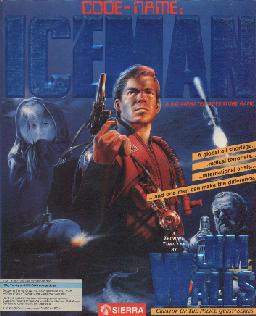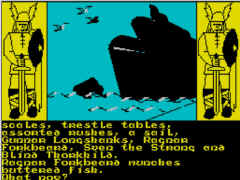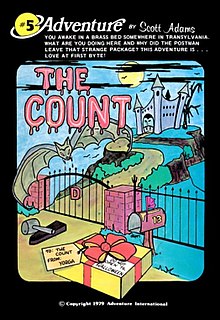Related Research Articles
Interactive fiction, often abbreviated IF, is software simulating environments in which players use text commands to control characters and influence the environment. Works in this form can be understood as literary narratives, either in the form of interactive narratives or interactive narrations. These works can also be understood as a form of video game, either in the form of an adventure game or role-playing game. In common usage, the term refers to text adventures, a type of adventure game where the entire interface can be "text-only", however, graphical text adventures still fall under the text adventure category if the main way to interact with the game is by typing text. Some users of the term distinguish between interactive fiction, known as "Puzzle-free", that focuses on narrative, and "text adventures" that focus on puzzles.

Zork is one of the earliest interactive fiction computer games, with roots drawn from the original genre game Colossal Cave Adventure. The first version of Zork was written between 1977 and 1979 using the MDL programming language on a DEC PDP-10 computer. The authors—Tim Anderson, Marc Blank, Bruce Daniels, and Dave Lebling—were members of the MIT Dynamic Modelling Group.

A parse tree or parsing tree or derivation tree or concrete syntax tree is an ordered, rooted tree that represents the syntactic structure of a string according to some context-free grammar. The term parse tree itself is used primarily in computational linguistics; in theoretical syntax, the term syntax tree is more common.
Text Adventure Development System (TADS) is a prototype-based domain-specific programming language and set of standard libraries for creating interactive fiction (IF) games.
Action-adventure is a video game genre that combines core elements from both the action game and adventure game genres.

Enchanter is a 1983 interactive fiction computer game written by Marc Blank and Dave Lebling and published by Infocom. It belongs to the fantasy genre and was the first fantasy game published by Infocom after the Zork trilogy. The game had a parser that understood over 700 words, making it the most advanced interactive fiction game of its time. It was Infocom's ninth game.

Codename: ICEMAN is a graphical adventure game made with the SCI engine and published by the American computer game company Sierra On-Line in 1989. The lead designer was Jim Walls, who also created several Police Quest games. Mention of a "Codename: PHOENIX" in Sierra promotional material suggests that ICEMAN was meant to be the first part of a Codename series, but disappointing sales ended the would-be franchise after one game.
In adventure games, a text parser takes typed input from the player and simplifies it to something the game can understand. Usually, words with the same meaning are turned into the same word and certain filler words are dropped.

The Hobbit is an illustrated text adventure computer game released in 1982 for the ZX Spectrum home computer and based on the book The Hobbit, by J. R. R. Tolkien. It was developed at Beam Software by Philip Mitchell and Veronika Megler and published by Melbourne House. It was later converted to most home computers available at the time including the Commodore 64, BBC Micro and Oric computers. By arrangement with the book publishers, a copy of the book was included with each game sold.

Labyrinth: The Computer Game is a 1986 graphic adventure game developed by Lucasfilm Games and published by Activision. Based on the fantasy film Labyrinth, it tasks the player with navigating a maze while solving puzzles and evading dangers. The player's goal is to find and defeat the main antagonist, Jareth, within 13 real-time hours. Unlike other adventure games of the period, Labyrinth does not feature a command-line interface. Instead, the player uses two scrolling "word wheel" menus on the screen to construct basic sentences.

Space Quest III: The Pirates of Pestulon is a 1989 graphic adventure game by Sierra On-Line, and the third game in the Space Quest series.
Attempto Controlled English (ACE) is a controlled natural language, i.e. a subset of standard English with a restricted syntax and restricted semantics described by a small set of construction and interpretation rules. It has been under development at the University of Zurich since 1995. In 2013, ACE version 6.7 was announced.

Pirate Adventure is a text adventure program written by Scott Adams.

The Saga of Erik the Viking is a text-based adventure game by developing studio Level 9 Computing, published by Mosaic Publishing in 1984. The game runs on Amstrad CPC, BBC model B, Commodore 64 and Sinclair ZX Spectrum.

The Count is a text adventure written by Scott Adams and published by Adventure International in 1979. The player character has been sent to defeat the vampire Count Dracula by the local Transylvanian villagers, and must obtain and use items from around the vampire's castle in order to defeat him.
Castle Marrach is an online multiplayer video game by Skotos. The game revolves around the world of Queen Vivienne, a half-fae, half-human sovereign queen, and the mysteries of Her secluded realm atop Mount Ardan. Players take the role of "newly awoken" individuals who can barely remember their past before being revived in the Castle.

Police Quest II: The Vengeance is an adventure game produced by Jim Walls for Sierra On-Line, and released in 1988. It is the sequel to Police Quest: In Pursuit of the Death Angel and is part of the Police Quest series.

Portopia Renzoku Satsujin Jiken, often translated to The Portopia Serial Murder Case in English, is an adventure game designed by Yuji Horii and published by Enix. It was first released on the NEC PC-6001 in June 1983, and has since been ported to other personal computers, the Nintendo Famicom, and mobile phone services.
Beyond the Tesseract is a text based adventure game developed in 1983 by Canadian author David Lo for the TRS-80. The game was notable for its unique take on the genre and approach to mathematical entities and abstract concepts. In one section the player must navigate a text adventure game, inside the text adventure game. In another the player, while asleep, derives a proof using physical representations of various symbolic logic components.
An adventure game is a video game in which the player assumes the role of a protagonist in an interactive story driven by exploration and puzzle-solving. The genre's focus on story allows it to draw heavily from other narrative-based media, literature and film, encompassing a wide variety of literary genres. Many adventure games are designed for a single player, since this emphasis on story and character makes multiplayer design difficult. Colossal Cave Adventure is identified as the first such adventure game, first released in 1976, while other notable adventure game series include Zork, King's Quest, The Secret of Monkey Island, and Myst.
References
- 1 2 Ashman, Alex (2007-05-10). "How to Make a Text-Based Adventure: Commands and Parser". h2g2 . BBC. Retrieved 2011-07-03.
- ↑ Hastings, Dan. "Natural Command Handling". Imaginary Realities . Archived from the original on 2001-02-05.
All possible commands can be made known to the players, eliminating the frustrating 'syntax quest' to guess the command that does what you want in this particular room.
- ↑ Roberts, Michael J. (2002-01-05). "Chapter Ten: Advanced TADS Techniques". TADS 2 Author’s Manual. tads.org. Retrieved 2011-07-03.